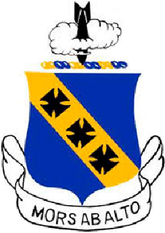
7th Operations Group
The 7th Operations Group is the operational flying component of the United States Air Force 7th Bomb Wing, stationed at Dyess Air Force Base, Texas. The 7th Operations Group currently flies the B-1 Lancer.
7th Operations Group
6 September 1918 – present
(104 years, 7 months)
- 1 October 1993 – present
29 August 1991 – 1 January 1993 (as 7th Operations Group)
20 July 1948 – 16 June 1952 (as 7th Bombardment Group, Heavy)
1 October 1946 – 20 July 1948 (as 7th Bombardment Group, Very Heavy)
15 October 1944 – 6 January 1946 (as 7th Bombardment Group, Heavy)
6 December 1939 – 15 October 1944 (as 7th Bombardment Group (Heavy))
24 March 1923 – 6 December 1939 (as 7th Bombardment Group)
25 January 1923 – 24 March 1923 (as 7th Observation Group)
26 March 1921 – 30 August 1921 (as 7th Group (Observation))
6 September 1918 – April 1919 (as 1st Army Observation Group)[1]
![]() United States Air Force (18 September 1947 – present)
United States Air Force (18 September 1947 – present)
![]() United States Army (
United States Army (![]() Army Air Forces, 20 June 1941 – 18 September 1947;
Army Air Forces, 20 June 1941 – 18 September 1947; ![]() Army Air Corps, 2 July 1926 – 20 June 1941;
Army Air Corps, 2 July 1926 – 20 June 1941; ![]() Army Air Service, 6 September 1918 – 2 July 1926)
Army Air Service, 6 September 1918 – 2 July 1926)
Dyess Air Force Base, Texas.
Mors Ab Alto Latin Death from Above
DY
The 7th Operations Group is a direct successor organization of the 7th Bombardment Group, one of the 15 original combat air groups formed by the United States Army before World War II.
Activated in 1921, it inherited the lineage of the 1st Army Observation Group, which was established and organized, on 6 September 1918. The 7th Bombardment Group was deploying to the Philippines when the Imperial Japanese Navy Air Service attacked Pearl Harbor on 7 December 1941. Six of the group's B-17 Flying Fortress aircraft which had left Hamilton Field, California on 6 December 1941 reached Hawaii during the enemy attack, but were able to land safely. The unit later served in India during World War II.
In the postwar era, the 7d Bombardment Group was one of the first USAAF units assigned to the Strategic Air Command on 1 October 1946, prior to the establishment of the United States Air Force. Equipped with low-hour B-29 Superfortress surplus World War II aircraft, the group was inactivated in 1952 when the parent wing adopted the Tri-Deputate organization and assigned all of the group's squadrons directly to the wing.
Reactivated as the 7th Operations Group in 1991 when the 7th Bomb Wing adopted the USAF Objective organization plan.
The 7 OG (Tail Code: DY) consists of the following units:
Both the 9th and 28th Bomb Squadrons fought in combat on the Western Front of World War I, and histories predate that of the Operations Group.
Heraldry[edit]
The group's emblem, approved in 1933, features three crosses symbolizing its squadrons' battle honors. The diagonal stripe was taken from the coat of arms of Province of Lorraine which France took back from Germany in World War I.

